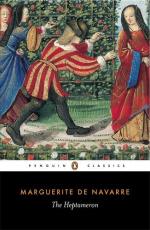|
This section contains 5,023 words (approx. 17 pages at 300 words per page) |

|
SOURCE: “‘Qui sommes tous cassez du harnoys’ or, the Heptaméron and Uses of the Male Body,” in Heroic Virtue, Comic Infidelity: Reassessing Marguerite de Navarre's Heptaméron, edited by Dora E. Polachek, Hestia Press, 1993, pp. 90-102.
In the following essay, Persels discusses Marguerite's challenge to the image of the aggressive and exaggeratedly virile male body.
The Heptaméron offers discursive portraits of five men who represent the few possible variations on the theme of noble Early Modern masculinity, from the apparently uncompromising, ostentatious virility of Hircan to the ultimately misleading, Neo-Platonic “feminism” of Dagoucin, (or “dagoucinisme,” to use Philippe de Lajarte's term [363]), with Saffredent, Simontault and Geburon serving as internal gradations of this range. Marguerite's tellers debate throughout the male's “carnal” nature, so succinctly delineated by Parlamente: “vostre plaisir gist à deshonorer les femmes, et vostre honneur à tuer les hommes en guerre: qui sont deux poinctz formellement contraires...
|
This section contains 5,023 words (approx. 17 pages at 300 words per page) |

|


